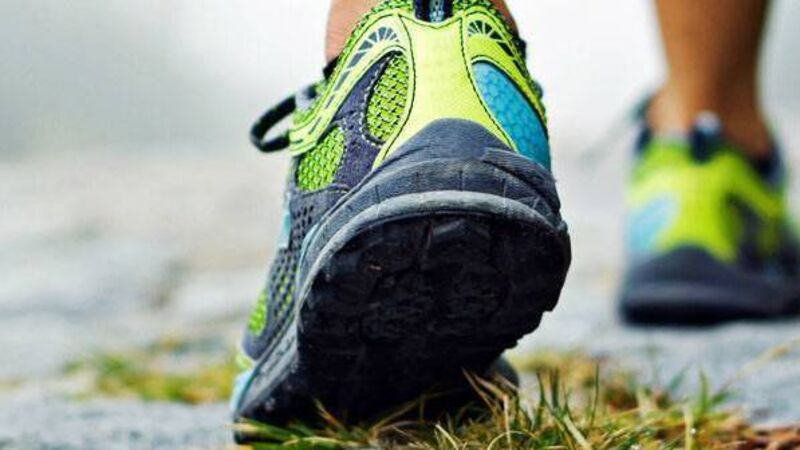How walking 10,000 steps a day can impact blood pressure, sleep patterns and mood

If you take 10,000 steps a day you can reduce your blood pressure, have more stable glucose levels and improve sleep patterns and mood.
Looking for a proven tonic for mental and physical health, something that is a boost for the heart and joints as well as for the mind?
Then take a walk.
Brisk walking has been shown to enhance our health and Professor Mick Molloy, Dean of the Faculty of Sports and Exercise Medicine at the Royal College of Physicians of Ireland, says it is an undervalued panacea for wellbeing: “Walking, quickly if you can, is one of the best things we can do to stay healthy. It’s a hugely valuable health tool because it is something that is accessible to us all and it is free, making it an activity that can quickly become habit-forming for a range of health improvements.”
In the latest study to promote its benefits show that it is also powerful antidote to low back pain, a condition that was labelled a global epidemic in the Lancet last year and affects 619 million people worldwide.
With statistics published in the Journal of Physiotherapy showing that more than two-thirds of low back pain sufferers having a recurrence within 12 months of initial recovery, anything that promises to help will be welcomed by those that experience it. And it is Australian researchers who bring the good news that low back pain can be avoided by using nothing more than your own two feet.
For their study in the Lancet, the team from Macquarie University's Spinal Pain Research Group recruited 701 people, aged 20 to 82, all of whom had experienced lower back pain within the previous six months that had then got better. After 12 weeks, those asked to take up walking were clocking an average of 130 minutes a week or 26 minutes on each of their five allotted days. After 1-3 years, results showed that the activity was indeed a low-cost and simple remedy for back problems: the walkers typically lasted nearly twice as long without a recurrence of their pain than people who didn’t adopt a walking plan.
Chopping and changing the length of your stride as you walk can help you burn more calories according to another new study by Adam Grimmitt, a researcher in the department of kinesiology at the University of Masachusetts. Grimmett asked a group of participants to walk on a treadmill for five minutes with their usual gait using technology to measure their average stride length and later asked the same group to walk with strides that were either five per cent longer or shorter than usual.
His published results showed that for every single percentage change in step length, there was a 0.7% increase in the metabolic cost of walking — that is the energy expenditure, or calorie burn, of the activity. “Step length variability plays a modest, albeit significant role in the metabolic cost of walking,” Grimmitt said.

Niall Moyna, professor in the School of Health & Human Performance at Dublin City University, says that walking is an important activity for preserving cardiovascular health as we get older. “If you haven’t done much activity in a while, then walking is always a starting point,” he says. “The more of it you do, and at a brisk pace, the more you will raise your heart and breathing rate and, in turn, your cardiovascular fitness.” Walking briskly on varied terrain with a few hills thrown in engages the same muscles used in running including the hamstrings and quadriceps in the thighs, iliopsoas muscles at the front of the hips and the gluteus maximus muscles but with less impact on the joints. It won’t work your body as hard as running and progress will be slower, but it’s a great baseline activity for those who want to get fitter.
In general, you need to walk for at least twice as long as you run for similar returns. One study of 55,137 adults showed how frequent 25-minute runs or 105-minute walks resulted in a 35 per cent lower risk of dying during the following eight years. Those researchers concluded that five minutes of daily running would bring similar health benefits to 15 minutes a day of brisk walking.
Others have suggested that walking at a brisk pace burns 3.8 times and running 7-12 times as much energy as sitting. In a study of 33,060 regular runners and 15,045 walkers , the authors estimated that someone would need to walk 4.3 miles at a brisk pace to use the same amount of energy as they would running 3 miles, and that the walk would take about twice as long.
If the purpose of a walk is to clear your mind and relieve stress, then a gentle stroll is enough to do the trick. A review of studies by a team of from Anglia Ruskin University (ARU) published in the journal Neuroscience and Biobehavioural Reviews recently found that physical activity reduced the risk of depression by 23% and anxiety by 26% with the most potent being low intensity activity such as walking. “Given that these levels of activity may be more achievable for people who can make smaller lifestyle changes without feeling they need to commit to a high-intensity exercise programme," said Lee Smith, professor of public health at ARU and lead author of the paper.

Most studies showing that walking enhances health and fitness are based on a 'brisk' walking pace of at least 100 steps per minute or about or 2.7mph. Tests conducted at University of Massachusetts suggest that 130 steps per minute (4mph) constitutes ‘vigorous walking’ for 21 to 60 year olds.
For the over 60s, walking as close to 100 steps a minute however old you are is a good goal. The more often you can pick up the pace, even in short bursts, the better. Research involving 405,981 middle aged adults showed that speedy daily walkers can have a biological age 15 years younger than dawdlers.
Professor Thomas Yates, a researcher in physical activity, sedentary behaviour and health, at the University of Leicester looked at length of telomeres, the 'bumpers' that protect DNA from damage, in participants. With age and bad habits — smoking, poor diet, inactivity — our telomeres shorten causing accelerated ageing of cells. But brisk walking was found to preserve telomere length, potentially reducing biological age by up to 15 years.
As any fitness tracker will make you aware, a daily total of 10,000 steps is considered a golden goal for activity. Despite being criticised in the past as an unscientific target — the figure was selected as part of a marketing campaign for pedometers in the 1960s — researchers at the University of Sydney have shown that between 9000 and 10,000 steps a day is indeed the amount needed to reduce the risk of an early death or heart-related event. There does seem to be a “dose response” when it comes to health improvements.
One study of 2,110 adults showed that totting up at least 7,000 daily steps from the age of 40 resulted in a 50% lower risk of premature death, but the researchers also found that people taking more than 10,000 steps a day rarely outlived those taking at least 7,000. This doesn’t mean that you shouldn’t do more than 10,000 steps as it will help your heart, lungs and fitness
If all you have time for is a short walk, set aside 12 minutes daily to do it. Researchers from the University of Cambridge reporting in the British Journal of Sports Medicine last year found that around this duration a day of brisk walking is enough to lower the risk of diseases such as heart disease, stroke and some forms of cancer.
Professor Yates and his Leicester colleagues found that 10 minutes of brisk walking could increase life expectancy for some people by three years. But you will need to set targets in order to reap the biggest rewards, says Moyna who created a set of guidelines for Sport Ireland detailing targets different age groups should aim for to increase fitnessIn the 12-minute walking challenge,
Moyna suggests men in their 40s aim to cover 1.4miles and women 1.2 miles while even in your 80s you should keep walking, aiming for a pace that sees you cover about a mile in 12 minutes. “How briskly you walk is a strong predictor of longevity,” Moyna says. “Doing an extra 2000 steps a day of brisk walking could bring massive improvements to your health.”
- Details can be found at sportireland.ie

Celebrating 25 years of health and wellbeing











